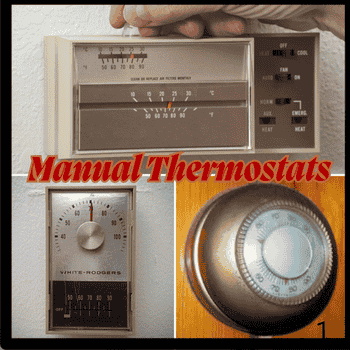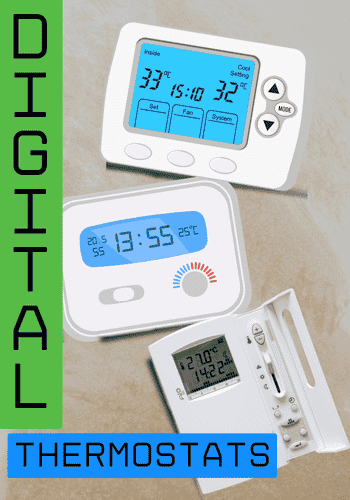How Many Types of Thermostats
Published: 12 Dec 2024
Table of Contents
How Many Types of Thermostats Are There?
A Comprehensive Guide
Thermostats are crucial in controlling the temperature of homes, offices, and industrial spaces. Whether using a basic manual or a high-tech smart thermostat, understanding the different types available can help you make the best choice for your needs. This guide will explore all kinds of thermostats, their uses, popular brands, availability, how they work, and more. Here, we evaluate how many types of Thermostats there are.
Types of Thermostats
Types of Thermostats can be categorized into three main types:
1-Manual Thermostats

- Mechanical Thermostats
- Dial Thermostats
- Slider Thermostats
2-Digital Thermostats

- Programmable Thermostats
- 5-2 Day Programmable Thermostats
- 7-Day Programmable Thermostats
- 5-1-1 Programmable Thermostats
3-Smart Thermostats

- Learning Thermostats
- Voice-Controlled Thermostats
- Geofencing Thermostats
Each type of thermostat has several variations based on technology, features, and usage.
1-Manual Thermostats
Manual Types of Thermostats and analog thermostats are the most straightforward and traditional types. They require users to adjust the temperature settings manually.
- Features:
- Basic temperature control.
- No advanced programming options.
- Cost-effective and reliable.
- Manual Types of Thermostats:
- Mechanical Types of Thermostats:
- Mechanical Thermostats: Rotate a dial or move a lever to set the temperature.
- Description: Simple, manual thermostats with essential temperature control.
- How They Work: A bimetallic strip or gas-filled bellows detect temperature changes.
- Where Used: Older homes, basic heating systems, and places where precise control is unnecessary.
- Popular Brands: Honeywell, Lux Products, White-Rodgers.
- Dial Types of Thermostats:
- It is controlled by turning a dial to set the desired temperature.
- Simple and durable.
- It is commonly used in older homes and small offices.
- Slider Types of Thermostats:
- Temperature is adjusted by sliding a lever.
- Easy to operate but less precise.
- Often found in budget-friendly installations.
Where Manual Types of Thermostats Are Used:
- Small residential spaces.
- Essential heating and cooling systems.
- Areas with minimal temperature fluctuation are needed.
Popular Brands:
- Honeywell Home: Offers reliable manual thermostats like the Honeywell T87N.
- Lux: Known for affordable options such as the Lux WIN100.
2-Digital Types of Thermostats
Digital Thermostats: Press buttons to adjust settings; some include touchscreens.
Programmable Types of Thermostats
Programmable Thermostats: Input schedules via buttons or screens.
- Description: Advanced thermostats with digital displays.
- How They Work: Electronic sensors measure temperature and provide precise control.
- Where Used: Modern homes, offices, and buildings requiring accuracy.
- Popular Brands: Emerson, Nest, Ecobee.
Programmable Types of Thermostats allow users to schedule temperature settings for different times of the day.
- Features:
- Customizable schedules.
- Energy-saving capabilities.
- Easy-to-use interface.
- Programmable Types of Thermostats:
- 7-Day Programmable Thermostats:
- Allows unique schedules for each day.
- It is ideal for households with varying daily routines.
- 5-2 Day Programmable Thermostats:
- Separate schedules for weekdays and weekends.
- Perfect for working professionals.
- 5-1-1 Programmable Thermostats:
- One schedule for weekdays and individual schedules for Saturday and Sunday.
- Flexible for mixed schedules.
Where Programmable Thermostats Are Used:
- Homes and offices with predictable schedules.
- HVAC systems with automatic heating and cooling.
Popular Brands:
- Nest (now owned by Google): Features intuitive designs like the Nest Thermostat E.
- Ecobee: Known for energy-efficient models like the Ecobee Lite.
- Emerson: Offers the budget-friendly Sensi ST55.
3-Smart Types of Thermostats Thermostats
Smart Thermostats: They can be operated using smartphone apps, voice commands (e.g., Alexa, Google Assistant), or built-in AI.
Smart thermostats represent the latest innovation in temperature control. They use Wi-Fi connectivity and advanced sensors for remote and automated temperature adjustments.
- Features:
- Remote control via smartphone apps.
- Integration with smart home systems.
- AI-driven learning to optimize energy usage.
- Types of Smart Thermostats:
- Learning Thermostats:
- Automatically adjust based on user habits.
- Examples: Nest Learning Thermostat.
- Voice-Controlled Thermostats:
- Compatible with voice assistants like Alexa, Google Assistant, and Siri.
- Examples: Ecobee SmartThermostat with voice control.
- Geofencing Thermostats:
- Adjust temperature based on the user’s location.
- Perfect for people on the go.
Where Smart Thermostats Are Used:
- Tech-savvy households.
- Offices and businesses aiming for energy efficiency.
- Homes with existing smart devices.
Popular Brands:
- Google Nest: Known for AI learning and sleek designs.
- Ecobee: Offers seamless integration with other smart home devices.
- Hive: Provides user-friendly, innovative Types of thermostat solutions.
How Thermostats Work
- Temperature Sensors:
- Thermostats detect the current temperature using built-in sensors.
- Control Mechanism:
- Manual thermostats use mechanical controls, while smart thermostats use digital and AI-based systems.
- Signal Transmission:
- Sends signals to the HVAC system to adjust heating or cooling based on the set temperature.
Advanced Smart Types of Thermostat Features
Smart thermostats offer additional features that make them highly desirable:
- Energy Reports: Track your energy usage and identify savings opportunities.
- Multi-Zone Control: Manage temperatures in different areas of your home.
- Humidity Sensors: Monitor and control indoor humidity levels.
- Vacation Mode: Save energy while you’re away from home.
Where Are These Thermostats Used?
Each thermostat type serves different applications:
- Homes: Digital, programmable, intelligent, and low-voltage thermostats are standard.
- Offices: Smart and zoned thermostats optimize energy use.
- Industrial Spaces: Mechanical and programmable thermostats for heavy-duty systems.
- Hotels: Wireless and zoned thermostats for guest comfort.
- Warehouses: Heat pumps and low-voltage thermostats maintain specific conditions.
How Are These Thermostats Operated?
- Mechanical Thermostats: Rotate a dial or move a lever to set the temperature.
- Digital Thermostats: Press buttons to adjust settings; some include touchscreens.
- Programmable Thermostats: Input schedules via buttons or screens.
- Smart Thermostats: They can be operated using smartphone apps, voice commands (e.g., Alexa, Google Assistant), or built-in AI.
Where Can You Find These Thermostats?
- Online Retailers: Amazon, Best Buy, Home Depot, and Lowe’s offer a wide range of thermostats.
- Manufacturer Websites: Brands like Nest, Ecobee, and Honeywell sell directly online.
- Local HVAC Dealers: Provide professional installation along with the thermostat.
- Electronics Stores: Chains like Best Buy or Fry’s Electronics stock popular models.
- Home Improvement Stores: Home Depot and Lowe’s carry a variety of options.
Top Brands and Companies
- Honeywell Home: Offers thermostats for all budgets and needs.
- Nest (Google): Known for smart, energy-efficient thermostats.
- Ecobee: Provides feature-rich smart thermostats.
- Lux Products: Affordable and reliable options.
- Carrier and Trane: High-quality thermostats for HVAC systems.
- Mysa: Specializes in brilliant line voltage thermostats.
- Bosch Thermotechnology: Innovative and energy-efficient designs.
- White-Rodgers: Popular for mechanical and non-programmable options.
Tips for Choosing the Right Thermostat
- Consider Your HVAC System: Ensure compatibility with your system (e.g., heat pump, low voltage).
- Think About Features: Decide between basic, programmable, or innovative features.
- Budget: Mechanical and non-programmable models are more affordable.
- Installation Needs: Wireless models are easier to install.
- Energy Efficiency: Smart thermostats save more energy over time.
Comparison: Manual vs. Smart Thermostats
| Feature | Manual Thermostats | Smart Thermostats |
|---|---|---|
| Price | Affordable | Expensive |
| Ease of Use | Simple | Complex but intuitive |
| Connectivity | None | Wi-Fi-enabled |
| Energy Efficiency | Basic | Advanced savings |
| Customization | Limited | High |
Popular Thermostat Models and Features
Honeywell T9 Smart Thermostat:
- Compatible with Alexa and Google Assistant.
- Includes smart room sensors for accurate temperature control.
Nest Learning Thermostat (3rd Gen):
- Learns your schedule and adjusts automatically.
- Energy-efficient with a sleek design.
Ecobee SmartThermostat:
- Comes with a built-in speaker for voice commands.
- Works with popular smart home platforms.
Conclusion
Thermostats come in many types, each tailored to specific needs. Every application has a thermostat, whether you want essential temperature control or advanced innovative features. Research brands, check compatibility, and consider your budget before purchasing. With this guide, you’ll find the perfect thermostat to make your space more comfortable and efficient.
References
- Honeywell Home Official Website
- Nest by Google Official Website
- Ecobee Smart Thermostats Documentation
- Energy Star Thermostat Buying Guide
- ASHRAE Journal on Thermostat Technology
Frequently Asked Questions (FAQs)
1. What is the purpose of a thermostat?
A thermostat regulates temperature by controlling heating and cooling systems, ensuring comfort and energy efficiency.
2. What is the difference between a digital and a programmable thermostat?
A digital thermostat shows the temperature and allows manual adjustments, while a programmable thermostat lets you set temperature schedules.
3. Are smart thermostats worth the investment?
They save energy, offer convenience, and integrate with smart home systems.
4. Can I install a thermostat myself?
Some thermostats, like wireless or basic models, are easy to install. However, professional help is recommended for complex systems.
5. What type of thermostat is best for a heat pump?
Heat pump thermostats are specifically designed with settings for auxiliary and emergency heat.
6. Do smart thermostats work without Wi-Fi?
Yes, but their advanced features, like remote control and energy reports, require an internet connection.
7. How often should I replace my thermostat?
Replace your thermostat every 10 years or when it shows signs of malfunction.
8. Can a thermostat help lower energy bills?
Yes, programmable and smart thermostats optimize energy usage, reducing costs.
9. What is a zoned thermostat?
A thermostat separately controls different areas or “zones” in a building for customized comfort.
10. Which brands offer the best smart thermostats?
Top brands include Google Nest, Ecobee, Honeywell, and Amazon.
11. What is a line voltage thermostat?
It’s used for electric heating systems and works by controlling voltage to heating elements.
12. Are there thermostats for industrial use?
Yes, mechanical and programmable thermostats are standard in industrial applications.
13. How do I choose between wired and wireless thermostats?
Choose wireless for easy installation or retrofitting and wired for permanent setups with high reliability.
14. What is the most energy-efficient thermostat?
Smart thermostats like Nest or Ecobee are highly energy-efficient.
15. Where can I buy replacement parts for thermostats?
Parts are available on manufacturer websites, HVAC dealers, or online stores like Amazon and Home Depot.





